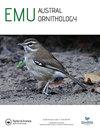Sympatric finches differ in visitation patterns to watering holes: implications for site-focused bird counts
IF 1.1
4区 生物学
Q3 ORNITHOLOGY
引用次数: 0
Abstract
ABSTRACT Estimating trends in population size is critical for understanding population status and assessing the success of management interventions. Visual counts of birds as they congregate around predictable locations, such as waterholes, is a popular technique for estimating population size. Bird counts are used as a proxy for abundance, but how the relationship between counts and actual abundance varies over space and time is rarely assessed. Here, we demonstrate that colour banding and motion detection cameras provided a good method for monitoring finch visitation patterns across space and time. These methods were validated using three sympatric finch species, the abundance of which have been estimated from waterhole counts over many years. The study showed significant temporal inter-species variability in the proportion of birds visiting waterholes and the number of times the same individual returned to the same waterhole during the early morning. Bird visitation rates also varied between consecutive days, across adjacent waterholes and at different stages of the dry season. Our study suggests that spatiotemporal variation in individual behaviour may introduce substantial error into site-focused bird counts and we recommend considering this in census design.同域雀鸟对水坑的访问模式不同:对以地点为中心的鸟类计数的影响
估算种群规模的趋势对于了解种群状况和评估管理干预措施的成功与否至关重要。当鸟类聚集在可预测的地点(如水坑)时,对它们进行视觉计数是估计种群规模的一种流行技术。鸟类数量被用作丰度的代表,但鸟类数量和实际丰度之间的关系如何随着时间和空间的变化而变化,很少得到评估。在这里,我们证明了彩色带和运动检测摄像机提供了一个很好的方法来监测雀的访问模式跨越空间和时间。这些方法是用三种同域雀来验证的,它们的丰度是通过多年来的水坑计数来估计的。研究表明,在鸟类访问水坑的比例和同一个体在清晨返回同一水坑的次数方面,物种间存在显著的时间差异。鸟类的到访率在连续的日子里,在邻近的水坑里,在旱季的不同阶段也有所不同。我们的研究表明,个体行为的时空变化可能会给以地点为中心的鸟类计数带来实质性的误差,我们建议在普查设计中考虑到这一点。
本文章由计算机程序翻译,如有差异,请以英文原文为准。
求助全文
约1分钟内获得全文
求助全文
来源期刊

Emu-Austral Ornithology
生物-鸟类学
CiteScore
2.00
自引率
7.70%
发文量
33
审稿时长
>12 weeks
期刊介绍:
Emu – Austral Ornithology is the premier journal for ornithological research and reviews related to the Southern Hemisphere and adjacent tropics. The journal has a long and proud tradition of publishing articles on many aspects of the biology of birds, particularly their conservation and management.
 求助内容:
求助内容: 应助结果提醒方式:
应助结果提醒方式:


